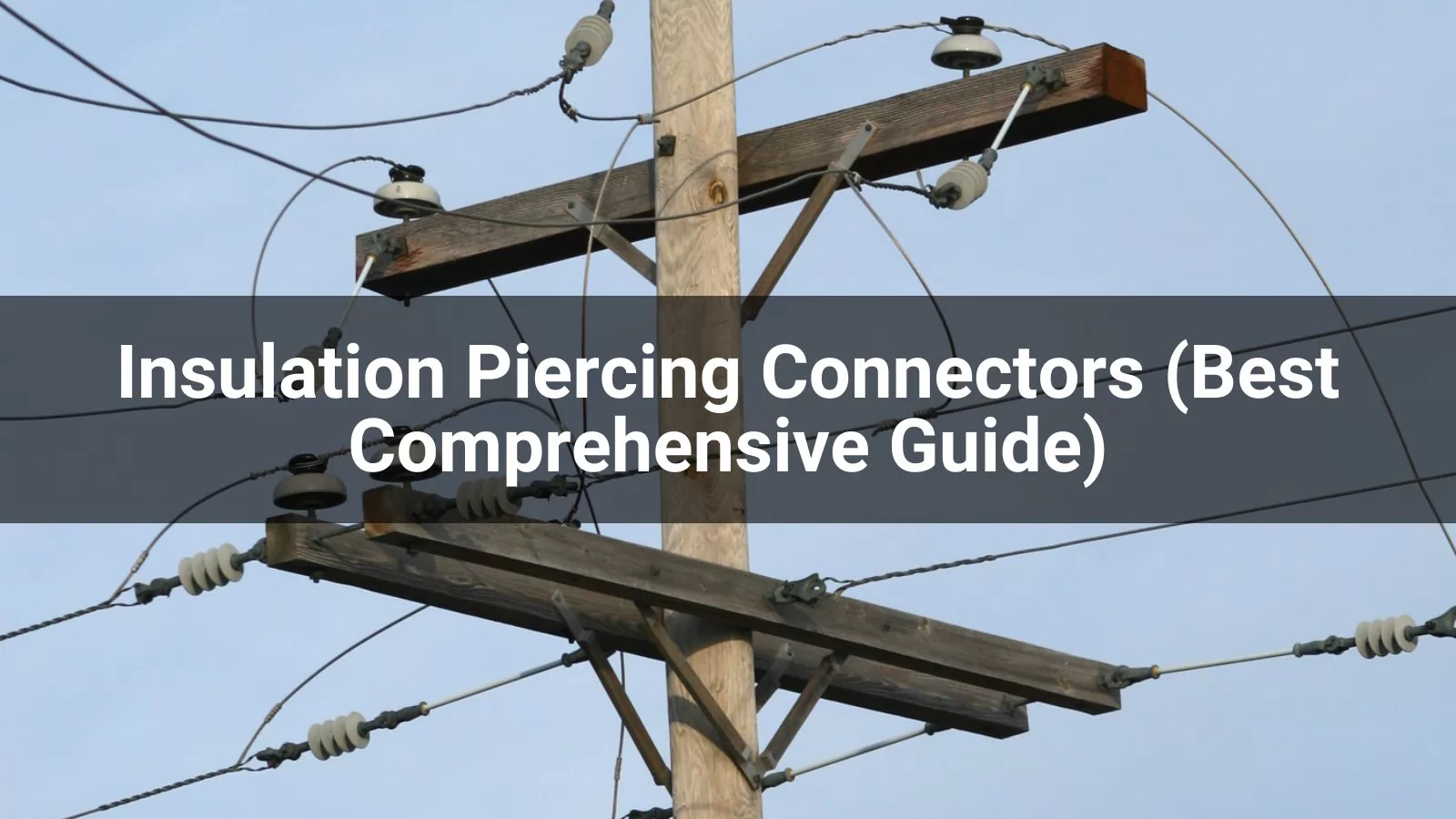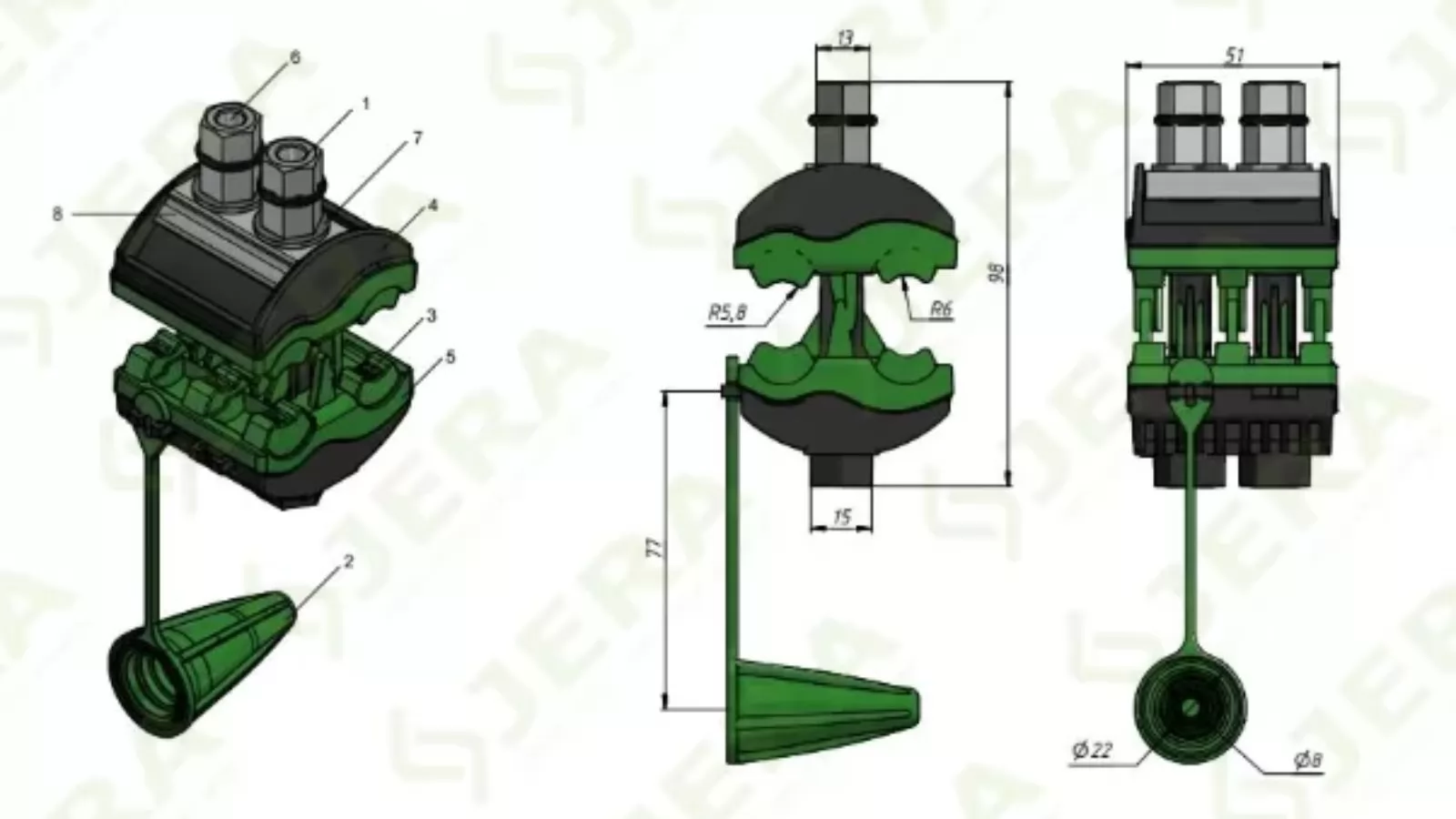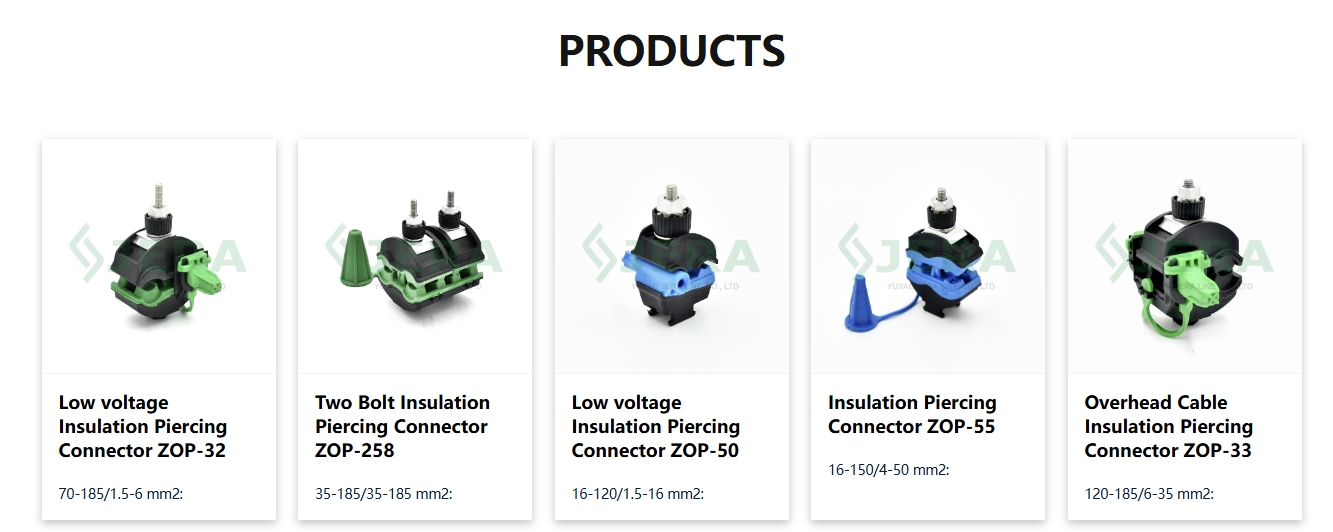


Insulation Piercing Connectors, commonly known as IPC connectors, are innovative and highly efficient electrical connectors designed to join insulated conductors without the need for removing the insulation beforehand. These connectors are widely used in overhead and underground power distribution systems, making them indispensable in electrical installations due to their convenience and effectiveness.
IPC connectors work by using sharp metallic teeth that pierce through the insulation of the conductors when tightened, establishing a strong, secure electrical connection. This unique design allows for a quick, hassle-free installation process without exposing the bare wire, which greatly reduces the risk of short circuits, corrosion, and other common issues associated with traditional connector methods.

At the core of the connector is the insulating body. This part is typically made from a highly durable, non-conductive material such as thermoplastic or reinforced polymer. Its main purpose is to provide electrical insulation and protect the internal components from external elements such as moisture, dust, and extreme temperatures. The insulating body also ensures that the conductive parts are not exposed, thereby maintaining the integrity of the connection.
· Material: Reinforced plastic or thermoplastic.
· Purpose: Protection from environmental factors and insulation.
The piercing teeth are the heart of the IPC connector. Made of hardened metal, usually copper or aluminum, these sharp teeth are designed to pierce through the insulation of the cable. As the connector is tightened, the teeth penetrate the insulation without damaging the conductor, ensuring that a secure electrical contact is made.
· Material: Hardened metal (copper, aluminum, or a combination).
· Purpose: Pierce the insulation and create contact with the conductor.
· Design: Often serrated or sharpened for optimal piercing without causing damage to the core conductor.
The bolts and clamping mechanism are responsible for the pressure applied during installation. Typically made of stainless steel or galvanized steel, these bolts ensure that the piercing teeth properly puncture the insulation and make firm contact with the conductor. Once tightened, they secure the connection and maintain it over time, preventing loosening due to environmental factors like vibrations or expansion and contraction caused by temperature changes.
· Material: Stainless steel or galvanized steel.
· Purpose: Apply pressure to engage the piercing teeth and secure the connection.
· Design: The bolts are usually corrosion-resistant to ensure durability in different climates.
Many IPC connectors come equipped with sealing gaskets or rubber rings that ensure the connection remains waterproof. These components are especially important in outdoor or underground installations, where exposure to rain, snow, or moisture could otherwise cause electrical failure or corrosion over time. The sealing ensures that the connection is airtight and waterproof, providing long-lasting protection.
· Material: Rubber or silicone-based sealing rings.
· Purpose: Prevent moisture, dust, and other contaminants from entering the connection.
· Design: Often placed around the piercing area to create a tight seal once the connector is clamped.
To prevent over-tightening, IPC connectors often use shear head bolts. These bolts have a predetermined breaking point, ensuring that the right amount of torque is applied during installation. Once the correct pressure is achieved, the head of the bolt shears off, leaving the rest securely in place. This feature is essential in preventing damage to the conductor and ensuring consistency in the installation process.
· Material: Stainless steel or similar alloys.
· Purpose: Prevent over-tightening, ensuring uniform pressure and proper installation.
· Design: Breaks off once optimal torque is reached, leaving a flush, secure finish.
The conductor slots are the spaces where the insulated wires are inserted. These slots are carefully sized to accommodate a range of conductor sizes, depending on the specific model of the IPC connector. The size of these slots can vary, but they are designed to hold the conductors firmly in place while the piercing teeth make contact.
· Material: Plastic or metal, depending on the connector design.
· Purpose: Hold conductors in place during installation.
· Design: Sized to fit various conductor diameters, ensuring versatility.
Some IPC connectors come with end caps that serve as protective covers for the ends of the conductors after installation. These caps help to prevent moisture from entering the ends of the wires, further safeguarding the electrical connection. While not always necessary, end caps are commonly used in outdoor applications for added protection.
· Material: Plastic or rubber.
· Purpose: Protect exposed conductor ends from moisture and dust.
· Design: Usually snap-on for ease of use, adding an extra layer of protection.

One of the most common applications of IPC connectors is in overhead power distribution. In these systems, electrical cables are exposed to outdoor elements such as wind, rain, and extreme temperatures. The unique design of IPC connectors makes them particularly suitable for this environment, as they allow for fast, secure connections between insulated conductors without exposing the bare wire to these external factors.
· Example Use: IPC connectors are often used to connect low, medium, and high-voltage cables in overhead electrical grids, ensuring consistent and safe transmission of electricity.
· Benefit: Their waterproof and corrosion-resistant properties make them ideal for overhead applications, where environmental factors can otherwise damage exposed wiring.
IPC connectors are equally useful in underground power distribution systems. When laying cables underground, it is essential to maintain the integrity of the insulation to prevent issues such as short circuits or moisture ingress. The piercing technology used in IPC connectors ensures that the connection is made without removing the insulation, which is critical in underground installations where access to cables is often limited.
· Example Use: In cities and suburban areas, IPC connectors are commonly used in underground electrical grids, such as those for residential or commercial power supply.
· Benefit: They ensure long-term, stable connections in underground settings, which are particularly prone to moisture and environmental hazards.
Another prominent use of IPC connectors is in street lighting systems. These connectors allow for easy branching of service cables from the main power lines to the streetlight poles. Because they don't require the insulation to be removed, the installation process is quick and straightforward, reducing labor costs and making it easier to maintain street lighting infrastructure.
· Example Use: Electricians use IPC connectors to connect individual streetlights to the main power supply in urban and rural areas.
· Benefit: The simplicity of the installation process and the durability of the connection make IPC connectors a popular choice for street lighting systems, where reliability is key.
With the rise of renewable energy systems, such as solar and wind power installations, IPC connectors have found a new range of applications. These connectors are used to link cables in photovoltaic systems, wind farms, and other renewable energy setups. Since renewable energy systems are often located in harsh outdoor environments, IPC connectors provide the necessary durability and weather resistance to ensure reliable connections over time.
· Example Use: In solar power systems, IPC connectors are often used to connect solar panels to the main power grid or to other components within the system.
· Benefit: Their ability to withstand environmental conditions, along with their waterproofing and corrosion-resistant properties, makes them ideal for renewable energy applications.
IPC connectors are commonly used for service connections in residential, commercial, and industrial settings. These are the points where power is transferred from the utility's main lines to a building's electrical system. By using IPC connectors, electricians can quickly and efficiently make these connections without compromising the integrity of the insulated conductors.
· Example Use: IPC connectors are used when connecting homes or businesses to the main power supply, ensuring that power is distributed safely and effectively.
· Benefit: Their ease of use and secure connections help reduce installation time and improve safety in residential and commercial electrical systems.
In railway and transit systems, electrical components must be robust and reliable to withstand continuous operation in dynamic environments. IPC connectors are often used in railway electrification systems to connect insulated conductors. Their ability to provide secure, insulated connections helps ensure that trains and other transit systems operate smoothly without electrical failures.
· Example Use: Railway systems use IPC connectors to join overhead power lines that provide electricity to electric trains and trams.
· Benefit: Their ability to maintain stable connections in vibrating and harsh environments makes them perfect for transit and railway applications.
IPC connectors are frequently employed in industrial and commercial applications where large, insulated conductors need to be joined without significant downtime. Factories, data centers, and other large-scale operations depend on consistent power distribution, and IPC connectors help ensure this by allowing for quick and reliable electrical connections.
· Example Use: Industrial facilities use IPC connectors to connect insulated wires to various machinery and equipment without interrupting ongoing processes.
· Benefit: Their speed of installation and cost-effectiveness make them ideal for large-scale commercial and industrial power setups.
Another important use case for IPC connectors is in temporary or emergency connections. In situations where rapid deployment of power systems is required, such as during a disaster recovery operation or a temporary event, IPC connectors enable electricians to quickly set up power grids. Their simple installation process allows for fast, reliable connections without specialized tools.
· Example Use: During a natural disaster or temporary events, IPC connectors are often used to set up temporary electrical grids.
· Benefit: Their ease of use makes them a go-to solution when speed and efficiency are critical in emergencies.
Advantages of Insulation Piercing Connectors
1. Time-Saving: Because there’s no need to strip the insulation, installation is faster compared to traditional connectors.
2. Enhanced Safety: The connectors reduce the risk of short circuits, electrical faults, and exposure to live conductors.
3. Durability: Designed for harsh environments, IPC connectors are resistant to moisture, UV exposure, and extreme temperatures.
4. Cost-Efficiency: Reduced labor time and long-lasting connections make them a cost-effective solution for various electrical applications.
In summary, Insulated Piercing Connectors are used in a wide range of electrical and utility applications, including overhead and underground power distribution, street lighting, renewable energy systems, and industrial setups. Their ability to simplify the connection process while maintaining safety and durability makes them a go-to solution in many different sectors. Whether it's a permanent electrical installation or a temporary emergency setup, IPC connectors provide a reliable, efficient, and safe method for joining insulated conductors.
Using IPCs on consumer meter tails can present several challenges, including:
· Safety risks such as overheating and arcing due to poor connections.
· Mechanical stress leading to connection failures over time.
· Long-term reliability concerns, especially in residential settings.
· Issues with smaller conductor sizes, where IPCs may not fit well.
· Corrosion risk due to environmental factors entering through the piercing points.
· Compatibility problems with consumer-grade electrical systems.
· Difficulties in maintenance and inspection due to the enclosed nature of the connectors.
Overall, while IPCs are incredibly useful in larger, utility-scale systems, their application in consumer-level installations, such as on meter tails, requires careful consideration. It's important to assess whether IPCs are the best solution for the specific electrical system, as traditional connectors may provide better long-term performance and safety in these scenarios.
Ultimately, choosing the correct connector—whether it’s an IPC or another type—requires a solid understanding of the electrical system’s demands, the environmental conditions, and the long-term performance expectations. By carefully considering these factors, IPCs can be a reliable and invaluable component of any electrical system.
This comprehensive guide to Insulation Piercing Connectors aims to provide a deeper understanding of the role IPCs play in modern electrical networks. Whether you're involved in large-scale electrical installations or handling residential connections, IPCs offer a unique blend of innovation and practicality. Understanding their use and limitations is key to making informed decisions for safer, more efficient electrical systems.









